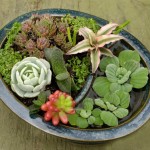By Cindy Hovis
During the commercial season of giving (and receiving), it is easy to be overwhelmed by the frantic pace of December. I’ve designed two gardening projects to help us maintain our sanity and to extend the gardening season through these winter months.
to be overwhelmed by the frantic pace of December. I’ve designed two gardening projects to help us maintain our sanity and to extend the gardening season through these winter months.
 to be overwhelmed by the frantic pace of December. I’ve designed two gardening projects to help us maintain our sanity and to extend the gardening season through these winter months.
to be overwhelmed by the frantic pace of December. I’ve designed two gardening projects to help us maintain our sanity and to extend the gardening season through these winter months.The first project is forcing spring bulbs. This could be as easy as purchasing an amaryllis “kit” that includes the container, the soil medium and the bulb itself and simply following the directions on the package and enjoying the beautiful flower. However, I usually tend to think “if one is good, then more is better.” I like to step out of “the box” and make my own containers.
I usually start by choosing a container that is shallow and filling the pot with pea-size gravel. I then place my bulbs close together (but not touching) and nestle (or twist) the bulbs down to facilitate a better root contact. I usually plant my narcissus and regular daffodils in these multi-bulb pots. A great thing to do for children is to use the traditional “forcing” vases for hyacinths and crocuses. These vases have a wide mouth and a nipped-in neck to accommodate and support the bulb. Simply fill the vase with water, and your child can see the roots growing in the bottom of the vase. Explain to your child that bulbs make and store their own food within the bulb itself. Hyacinths and crocuses must be cold treated, and this can be done in your refrigerator at home. Just place the bulbs in a shoebox filled with peat moss for a month. The bulbs will force easier with this treatment.
The next project is building a succulent pot to give as a gift or to decorate  your own home and table. Succulents come in a dazzling array of color and forms. The problem with them is that not all are winter-hardy–especially the more exotic forms. This is really not an issue since you are creating a microclimate in your garden dish. Choose a shallow dish three inches high. Combine a soil mix of 2-parts peat moss to 1-part sand. Go to the nearest full service garden center and check out the non-hardy succulent varieties. For my dish garden, I chose burro’s tail, burrito sedum, and several varieties of sempervivums that come in bright colors with the customary spider web pattern provided by the hairs on the tips of the leaves. For interest, add gravel and attractive rocks. This is a low maintenance dish garden that requires just a little water and plant food twice a year. This venue provides an excellent showcase for small plants that would be lost in the traditional garden. Personally, I don’t enjoy cacti but love the smooth fleshiness of succulents. Obviously, succulents are more child-friendly.
your own home and table. Succulents come in a dazzling array of color and forms. The problem with them is that not all are winter-hardy–especially the more exotic forms. This is really not an issue since you are creating a microclimate in your garden dish. Choose a shallow dish three inches high. Combine a soil mix of 2-parts peat moss to 1-part sand. Go to the nearest full service garden center and check out the non-hardy succulent varieties. For my dish garden, I chose burro’s tail, burrito sedum, and several varieties of sempervivums that come in bright colors with the customary spider web pattern provided by the hairs on the tips of the leaves. For interest, add gravel and attractive rocks. This is a low maintenance dish garden that requires just a little water and plant food twice a year. This venue provides an excellent showcase for small plants that would be lost in the traditional garden. Personally, I don’t enjoy cacti but love the smooth fleshiness of succulents. Obviously, succulents are more child-friendly.
 your own home and table. Succulents come in a dazzling array of color and forms. The problem with them is that not all are winter-hardy–especially the more exotic forms. This is really not an issue since you are creating a microclimate in your garden dish. Choose a shallow dish three inches high. Combine a soil mix of 2-parts peat moss to 1-part sand. Go to the nearest full service garden center and check out the non-hardy succulent varieties. For my dish garden, I chose burro’s tail, burrito sedum, and several varieties of sempervivums that come in bright colors with the customary spider web pattern provided by the hairs on the tips of the leaves. For interest, add gravel and attractive rocks. This is a low maintenance dish garden that requires just a little water and plant food twice a year. This venue provides an excellent showcase for small plants that would be lost in the traditional garden. Personally, I don’t enjoy cacti but love the smooth fleshiness of succulents. Obviously, succulents are more child-friendly.
your own home and table. Succulents come in a dazzling array of color and forms. The problem with them is that not all are winter-hardy–especially the more exotic forms. This is really not an issue since you are creating a microclimate in your garden dish. Choose a shallow dish three inches high. Combine a soil mix of 2-parts peat moss to 1-part sand. Go to the nearest full service garden center and check out the non-hardy succulent varieties. For my dish garden, I chose burro’s tail, burrito sedum, and several varieties of sempervivums that come in bright colors with the customary spider web pattern provided by the hairs on the tips of the leaves. For interest, add gravel and attractive rocks. This is a low maintenance dish garden that requires just a little water and plant food twice a year. This venue provides an excellent showcase for small plants that would be lost in the traditional garden. Personally, I don’t enjoy cacti but love the smooth fleshiness of succulents. Obviously, succulents are more child-friendly.I hope you make time in your busy schedule this month to try both of these projects. If possible, take some time to enjoy gardening with a child. You’ll be making memories that last much longer than the fleeting interest of opening a toy this holiday season.
